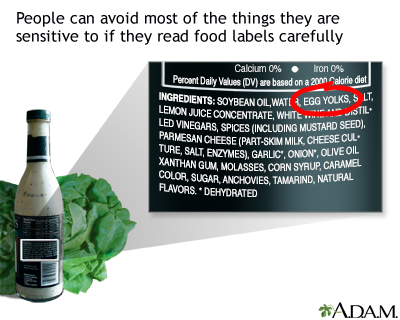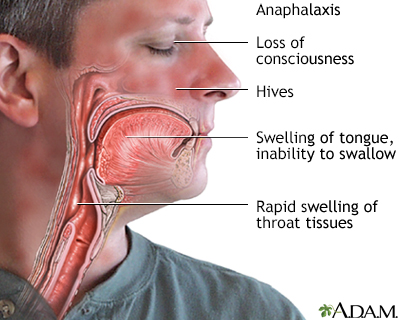Food allergy
A food allergy is a type of immune response triggered by eggs, peanuts, milk, shellfish or some other specific food.
Causes
Many people have a food intolerance. This term usually refers to heartburn, cramps, belly pain, or diarrhea that can occur after they eat foods such as:
Belly pain
Abdominal pain is pain that you feel anywhere between your chest and groin. This is often referred to as the stomach region or belly.

- Corn products
- Cow's milk and dairy products (usually due to lactose intolerance)
Lactose intolerance
Lactose is a type of sugar found in milk and other dairy products. An enzyme called lactase is needed by the body to digest lactose. Lactose intoler...
 ImageRead Article Now Book Mark Article
ImageRead Article Now Book Mark Article - Wheat and other grains that contain gluten (gluten intolerance or celiac disease)
Celiac disease
Celiac disease is an autoimmune condition that damages the lining of the small intestine. This damage comes from a reaction to eating gluten. This ...
 ImageRead Article Now Book Mark Article
ImageRead Article Now Book Mark Article
A true food allergy is much less common.
The immune system normally protects the body against harmful substances, such as bacteria and viruses. It also reacts to foreign substances called allergens. These are usually harmless, and in most people, do not cause a problem.
Allergens
An allergen is a substance that can cause an allergic reaction. In some people, the immune system recognizes allergens as foreign or dangerous. As ...


Food allergies
The body's immune system normally reacts to the presence of toxins, bacteria or viruses by producing a chemical reaction to fight these invaders. However, sometimes the immune system reacts to ordinarily benign substances such as food or pollen, to which it has become sensitive. This overreaction can cause symptoms from the mild (hives) to the severe (anaphylactic shock) upon subsequent exposure to the substance. An actual food allergy, as opposed to simple intolerance due to the lack of digesting enzymes, is indicated by the production of antibodies to the food allergen, and by the release of histamines and other chemicals into the blood.
In a person with a food allergy, the immune response is oversensitive. When it recognizes an allergen, the immune system launches a response. Chemicals such as histamines are released. These chemicals cause allergy symptoms.
Any food can cause an allergic reaction. The most common food allergies are to:
- Eggs (mostly in children)
- Fish (older children and adults)
- Milk (people of all ages)
- Peanuts (people of all ages)
- Shellfish such as shrimp, crab, and lobster (people of all ages)
- Soy (mostly in children)
- Tree nuts (people of all ages)
- Wheat (people of all ages)
In rare cases, food additives, such as dyes, thickeners, or preservatives can cause a food allergy or intolerance reaction.
Some people have an oral allergy. This is an allergy type syndrome that affects the mouth and tongue after they eat certain fresh fruits and vegetables:
- Melons, apples, peaches, pineapple, and other foods contain proteins that are similar to certain pollen proteins.
- The reaction most often occurs when you eat the raw form of the foods. How severe the reaction is depends on how much of the food you eat. If the food is cooked, there is no reaction.
- Unlike true food allergies, people with the oral allergy syndrome rarely develop severe allergic reactions such as anaphylaxis.
Symptoms
Symptoms usually begin within 2 hours after eating. Sometimes, the symptoms begin a longer time after eating the food.
Key symptoms of a food allergy include hives, a hoarse voice, and wheezing.
Hives
Hives are raised, often itchy, red bumps (welts) on the surface of the skin. They can be an allergic reaction to food or medicine. They can also ap...

Other symptoms that may occur include:
- Swelling (angioedema), especially of the eyelids, face, lips, and tongue
Angioedema
Angioedema is swelling that is similar to hives, but the swelling is under the skin instead of on the surface. Hives are often called welts. They a...
 ImageRead Article Now Book Mark Article
ImageRead Article Now Book Mark Article - Trouble swallowing or breathing due to swelling in the throat
- Itching of the mouth, throat, eyes, skin, or any other area
- Dizziness, lightheadedness, fainting, or feelings of impending doom
Fainting
Fainting is a brief loss of consciousness due to a drop in blood flow to the brain. The episode most often lasts less than a couple of minutes and y...
Read Article Now Book Mark Article - Nasal congestion, runny nose
- Stomach cramps, diarrhea, nausea, or vomiting
Stomach cramps
Abdominal pain is pain that you feel anywhere between your chest and groin. This is often referred to as the stomach region or belly.
 ImageRead Article Now Book Mark Article
ImageRead Article Now Book Mark Article

Perioral dermatitis
Perioral dermatitis is most common in young to middle age women. Frequently, no specific cause is found. However, there appears to be an association with fluorinated steroids. In children, dermatitis around the mouth may be associated with irritation from specific foods or other materials carried to the face on the hands.
Symptoms of mouth (oral) allergy syndrome:
- Itchy lips, tongue, and throat
- Swollen lips (sometimes)
Severe allergic reactions can happen immediately or within two hours after eating. This is called anaphylaxis and can be life threatening. In addition to the above symptoms, you may have low blood pressure and shortness of breath due to narrowed airways.
Anaphylaxis
Anaphylaxis is a life-threatening type of allergic reaction.

Low blood pressure
Low blood pressure occurs when blood pressure is below normal. This means the heart, brain, and other parts of the body may not get enough blood. I...

Exams and Tests
Blood or skin tests are sometimes used to confirm that you have an allergy. A double-blind food challenge is one way to diagnose true food allergies. During this test, you and your health care provider will not know what you are eating. This is not commonly done.
With elimination diets, you avoid the suspected food until your symptoms disappear. Then you start eating the foods again to see if you develop a reaction. This is only done for food sensitivities or mild reactions. If a food has caused severe symptoms in the past, this should not be attempted.
In provocation (challenge) testing, you eat a small amount of the suspected food under medical supervision. This type of test may cause severe allergic reactions. Challenge testing should only be done by a trained provider. Typically, this test is done when there is a question about whether there is a food allergy or not.
Never try to cause a reaction or reintroduce a food on your own. These tests should only be done under the guidance of a provider, especially if your first reaction was severe.
Allergy testing - Animation
Every time you walk into your backyard, you start sneezing, sniffling, and feeling like you want to go back indoors. You're pretty sure you have an allergy, but what are you allergic to? Pollen? Grass? Your neighbor's Golden retriever? The only way to know for sure what's making you sneeze is to have allergy tests at your doctor's office. Let's talk about allergy testing. Your doctor may do one or more of several different types of allergy tests to see what's causing your allergies. One is a skin test. It can diagnose allergies to things like mold, pollen, animal fur, insect stings, and foods. With a skin test, your doctor will place a small amount of one substance, or several different substances just under the surface of the skin on your arm or back. You'll feel a little prick when the substances are placed under your skin. After 15 minutes or so, the doctor will look for signs that you're having a reaction. Usually your skin will get red or swollen if you're allergic to something in the test. Another way to test for allergies is to put a patch of the substance on your skin and leave it there for about 2 days, checking the area every day for any sign of a reaction. You may have a blood test. A blood test measures the amount of substances called antibodies that your body produces in response to a certain allergen. If you're allergic to food, you can try avoiding whatever foods you think might be making you sick. This is called elimination testing. Then you add back in each of the foods, one at a time, and look for signs of an allergic reaction. Your doctor may also try to trigger an allergic reaction in the office by having you eat the food or breathe in the substance you think causes your allergy. This is called a challenge test. The one risk to this test is that, if you're severely allergic, you could have a very serious reaction. Your doctor will watch you very closely during this test to make sure you're safe. Allergy tests are usually pretty accurate. But sometimes what bothers you in the real world won't show up on the test. If you have one test and it doesn't find your allergy trigger, your doctor may recommend having another type of test. Don't worry if it takes a while to find the source of your allergies. Your doctor will keep trying different methods until you learn exactly what's making you so miserable.
Treatment
If you suspect that you or your child has a food allergy, see an allergy specialist (allergist).
Treatment may involve any of the following:
- Avoiding the food (this is the most effective treatment).
- Desensitization, during which you eat a small amount of the food each day. This must be done under an allergist's guidance.
- Omalizumab (Xolair), an injection every 2 or 4 weeks to decrease sensitivity to food allergies.
Other treatments, including allergy shots and probiotics, have not been proven to help with food allergies. However, some people find that their oral allergy symptoms improve after taking allergy shots.
If your child has a problem with cow's milk formula, your provider may suggest trying a soy-based formula or something called an elemental formula, if it is available.
If you have symptoms on only one area of your body, for example, a hive on your chin after eating the food, you may not need any treatment. The symptoms will likely go away in a brief time. Antihistamines may relieve the discomfort. Soothing skin creams may also provide some relief.
If you develop any type of serious or whole-body reaction (even hives) after eating a food, you should learn how to use injectable or intranasal epinephrine. You should have two epinephrine devices with you at all times.
- Use the epinephrine.
- Then go to the nearest hospital or emergency facility right away, preferably by ambulance.
- If you develop severe allergy symptoms or anaphylaxis, call 911 or the local emergency number.
Support Groups
The following groups can provide more information about food allergies:
- American Academy of Allergy Asthma and Immunology -- www.aaaai.org/Conditions-Treatments/Allergies/Food-Allergy
- Food Allergy Research and Education (FARE) -- www.foodallergy.org/
- National Institute of Allergy and Infectious Diseases -- www.niaid.nih.gov/diseases-conditions/food-allergy
Outlook (Prognosis)
Allergies to peanuts, tree nuts, and shellfish tend to last a lifetime.

Read food labels
Allergic reactions to a certain food can include diffuse hives, hoarse voice, wheezing, and, in severe reactions, low blood pressure and closing down of the windpipe. Medications such as antihistamines and skin creams may provide some relief from itching and rashes, but the best way to prevent future allergic reactions is to avoid the offending food in the first place. Reading the labels contained on most products is a useful way to find a certain food that a person may want to avoid.
Avoiding the problem foods may be easy if the food is uncommon or easy to identify. When eating away from home, ask detailed questions about the food you are served. When buying food, read package ingredients carefully.
Possible Complications

Anaphylaxis
Anaphylaxis is an acute systemic (whole body) type of allergic reaction which occurs when a person has become sensitized to a certain substance or allergen and is again exposed to the allergen. Some drugs, such as those used for pain relief or for x-rays, may cause an anaphylactoid reaction on first exposure. Histamines and other substances released into the bloodstream cause blood vessels to dilate and tissues to swell. Anaphylaxis may be life threatening if obstruction of the airway occurs, if blood pressure drops, or if heart arrhythmias occur.
Anaphylaxis is a severe, whole-body allergic reaction that is life threatening. People at risk for anaphylaxis should carry epinephrine with them at all times.
Although people with oral allergy syndrome may have an anaphylactic reaction in rare cases, they should ask their provider if they need to carry epinephrine.
Food allergies can trigger or worsen asthma, eczema, or other disorders.
Asthma
Asthma is a chronic disease that causes the airways of the lungs to swell and narrow. It leads to breathing difficulty such as wheezing, shortness o...

Eczema
Atopic dermatitis is a long-term (chronic) skin disorder that involves scaly and itchy rashes. It is a type of eczema. Other forms of dermatitis inc...

When to Contact a Medical Professional
Steps to take when a food allergy reaction occurs:
- Call 911 or the local emergency number if you have any serious or whole-body reactions, particularly wheezing or difficulty breathing, after eating any food.
- If your provider prescribed epinephrine for severe reactions, use it as soon as possible, even before calling 911. The sooner you use the epinephrine, the better.
- Anyone who has had an allergic reaction to a food, should be seen by an allergist.
Prevention
There is no known way to prevent food allergies.
Avoiding peanuts in early childhood does not appear to prevent, and may even enhance, the development of peanut allergy. Providers now suggest introducing peanut-containing foods to infants, which may prevent peanut allergy. There is also evidence that introducing eggs by 12 months of age can prevent egg allergy.
Once an allergy has developed, carefully avoiding the offending food usually prevents further problems.
Reviewed By
Deborah Pedersen, MD, MS, Allergy & Asthma Care, PC, Taunton, MA. Review provided by VeriMed Healthcare Network. Also reviewed by David C. Dugdale, MD, Medical Director, Brenda Conaway, Editorial Director, and the A.D.A.M. Editorial team.
Bird JA, Burks AW. Food allergy. In: Rich RR, Fleisher TA, Schroeder HW, Weyand CM, Corry DB, Puck JM, eds. Clinical Immunology. 6th ed. Philadelphia, PA: Elsevier; 2023:chap 49.
Sicherer SH, Lack G, Jones SM. Food allergy management. In: Burks AW, Holgate ST, O'Hehir RE, et al, eds. Middleton's Allergy: Principles and Practice. 9th ed. Philadelphia, PA: Elsevier; 2020:chap 82.
Togias A, Cooper SF, Acebal ML, et al. Addendum guidelines for the prevention of peanut allergy in the United States: report of the National Institute of Allergy and Infectious Diseases-sponsored expert panel. J Allergy Clin Immunol. 2017;139(1):29-44. PMID: 28065278 pubmed.ncbi.nlm.nih.gov/28065278/.



 All rights reserved.
All rights reserved.